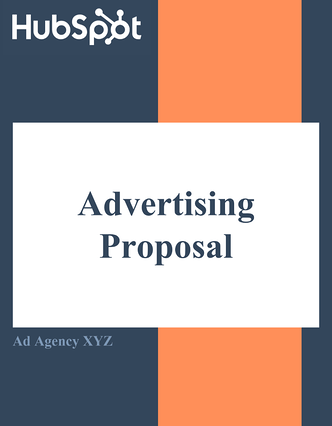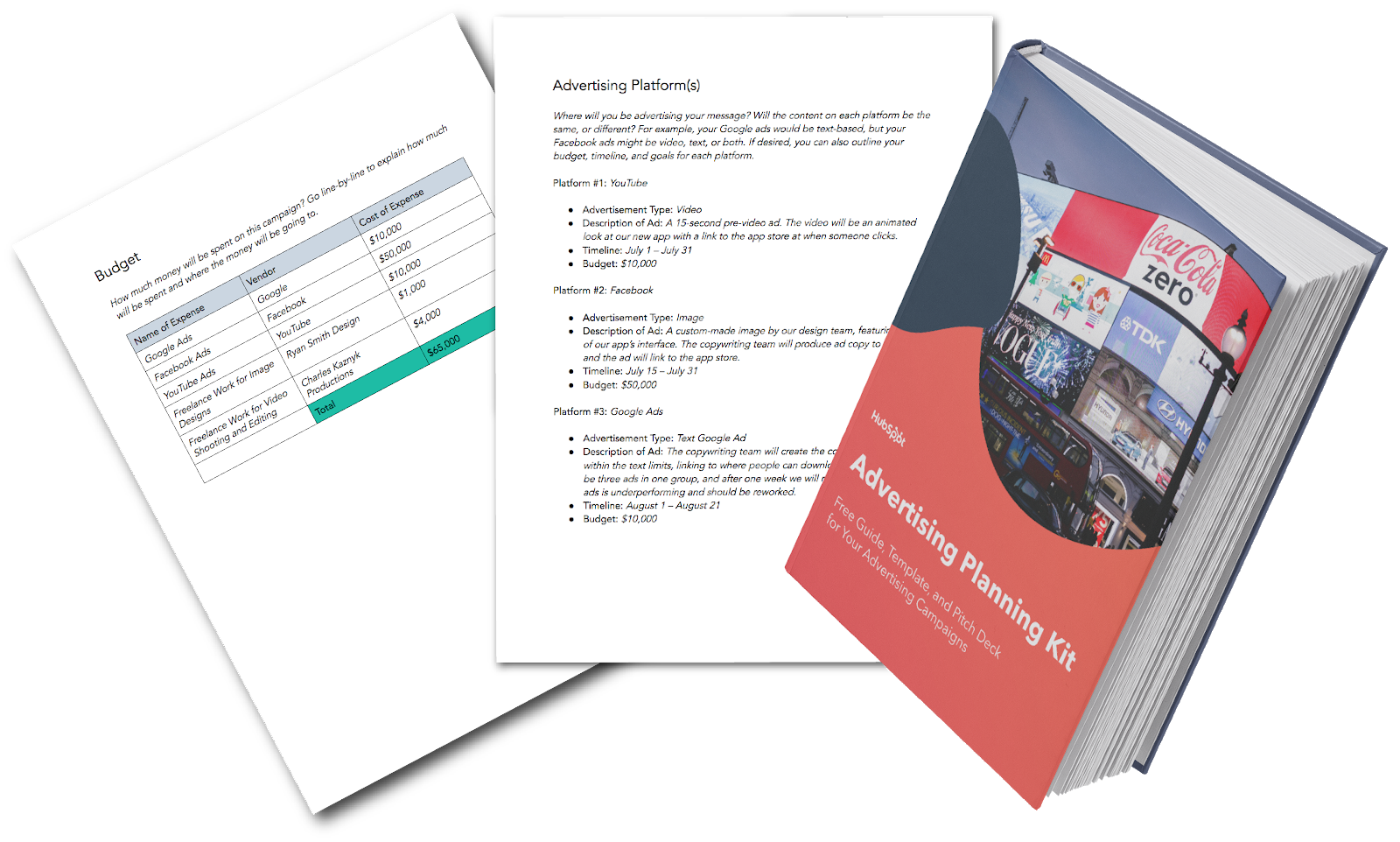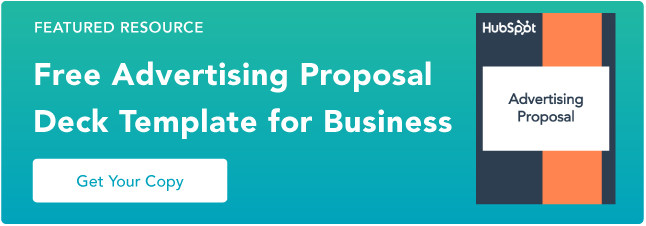Whether you're part of an internal marketing team or an agency developing an advertising pitch, it's imperative to nail your advertising proposal to gain stakeholder clarity and secure their buy-in.
After all, advertising is expensive, and a poorly managed campaign results in wasted funds and resources that fail to deliver a return on investment – which could hinder a company's ability to hit its awareness and sales goals.
Executives need to know that an advertising project has been well thought-out from all angles before they front the money to develop creative and buy advertising space. And the best way to inform and persuade these decision-makers is with a crystal clear and actionable advertising proposal.
In this article, we'll outline the actions to take, templates to use, and questions to answer when developing your advertising proposal, so you can get moving on your advertising project faster and maximize revenue from it.
Follow along with HubSpot's free Advertising Proposal Template for PowerPoint. The template is completely customizable to your business's needs and makes developing an advertising proposal presentation simple, covering sections thorough proposals need to have such as:
- Project timeline.
- Project team.
- Project budget and fees.
- … And more.
While the template is best-suited for marketing agencies, it can easily be adjusted for in-house marketing teams for internal project management. Download the template now to get started.
How to Make Your Advertising Proposal
1. Plan your advertising project.
Preparing an advertising plan is an essential first step in an advertising pitch project. As a rule of thumb, it's best practice to work off of an advertising plan template to ensure you check all the necessary boxes when it comes to the project.
In the next few sections, we'll highlight what you should include in your advertising plan and proposal, but the reason to start with this step is to ensure organization. By proactively setting up your framework, you'll be better suited to prioritize your tasks down the road and understand which roadblocks you might face – and in the process, get ahead of them.
2. Specify your tasks and/or services.
So, you're moving forward with your advertising proposal – but what exactly are you planning on doing?
The next step is to outline the scope of work for the project, including:
- Conducting market research.
- Choosing an advertising platform.
- Developing creative and copy.
- Working with media buying/selling vendors.
- Analyzing and presenting results.
Depending on the makeup of your team or agency, you might be responsible for some or all of these tasks – or perhaps some not even listed here.
The important thing to remember in this step is to make the expectations of what your team will be doing abundantly clear.
There should be no question from those to whom you're presenting regarding what will or won't be done by your team.
3. Pick your team members.
An advertising campaign requires contributions from marketing, sales, sales enablement, finance, and/or the product teams.
In your proposal, put faces to names by explaining who will be responsible for what. Naturally, this process might take more time if you're combining the efforts of those within and outside of your company, or if there are different team members in the same department who need to decide which person will be responsible.
4. Establish a timeline.
When boiled down, executives need to know what is happening and when it is happening. Thus, the next step in the process is to build a timeline for your activities.
Now that you have a list of those who will be involved in your campaign, work with their schedules and areas of expertise to determine who will be doing what, and at what point.
Your timeline should be clear, efficient, and attainable. When presenting your proposal, you don't want anyone feeling unsure about your team hitting its targets, but you also don't want to give off the impression that you're not moving as diligently as possible.
As such, be sure you can speak to why each step of the process will take as long as you're suggesting and what contingency plans – if any – you have in-place.
5. Solidify your budget.
The key distinction between marketing and advertising is budget. Advertising requires an additional investment to buy space on a desired platform, and when asking for money, you'll need to be transparent about how much you're asking for, and why.
Your budget outline should speak to all funds required to execute the campaign, such as:
- Agency fees (if applicable).
- Creative development fees for video, imagery, and/or graphic design elements.
- Advertising placement costs on your intended platform(s).
- Additional headcount (internally or freelancers).
Alongside your budget, you should also speak to the projected monetary impact of your advertising campaign, including both revenue and profit, and, if available, the projected increase in customers and unit sales. Adding these elements can help make the budget more justifiable.
6. Share your presentation.
Once you have all of these elements laid out in your advertising proposal, it's time to share your presentation.
If it's via email, make sure to include relevant articles or resources in your messaging or in an appendix, and encourage the email's recipients to promptly send any questions so you can address them and move forward with the project quickly.
If the presentation is in-person or over a video call, always be sure to rehearse your presentation – particularly if more than one person is explaining the proposal. As a best practice, you should leave ample time at the end of your presentation to answer any outstanding questions somebody may have before signing off on the proposal.
3 Tips for an Outstanding Advertising Proposal Presentation
1. Be creative.
You're being tasked to work on this advertising project because you're creative, so why would you allow your advertising proposal to be any less creative?
Make sure your proposal and presentation are filled with imagery and is well-designed. If appropriate, you might also want to consider throwing in some references, GIFs, or jokes to appeal to your audience's more lighthearted side.
2. Be clear.
We've said this already, but advertising campaigns can require enormous investments of time, resources, and capital. Leave absolutely no stone unturned in your presentation, or you might risk setting false expectations about your team's capabilities.
A lack of clarity might also convince your audience you haven't fully answered all questions, which could result in the decision to not move forward with the campaign. When it comes to numbers, timelines, and processes, clarity is key.
3. Be concise.
Finally, always remember that we're all pressed for time. While clarity is essential, there's no point in redundancy or wasting your audience's time. Some information is best suited to be clarified in the Q+A session after the presentation or in follow-up collateral if requested.
In your presentation, prioritize delivering the need-to-know information – but be prepared to follow-up on anything that needs clarification.
Delivering a Winning Advertising Proposal
With these steps and this template, you've got the foundation to bring your advertising campaign idea to life. Find the balance between clarity and creativity, know your numbers, explain your process, and you'll be on your way to getting your advertising proposal approved.

![How to Create an Advertising Proposal [Free Template]](https://no-cache.hubspot.com/cta/default/53/5207a139-6c65-41d0-8c86-7109cb4bd4f8.png)




